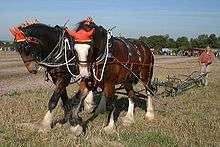Ploughman's lunch
|
A ploughman's lunch consisting of bread, butter, sliced onion, wedges of cheese, and ale | |
| Type | Meal |
|---|---|
| Place of origin | United Kingdom |
| Creator | Cheese Bureau |
| Main ingredients | Bread • cheese • pickle |
|
| |
A ploughman's lunch (abbrev. to ploughman's) is an English cold meal which consists of cheese, pickle, and bread.[1] Additional items such as apple, boiled eggs, ham, and pickled onions may be added. As its name suggests, it is more commonly consumed at midday.
Beer, bread, and cheese have been combined in the English diet since antiquity. However, the specific term "ploughman's lunch" is believed to date no further back than the 1950s, when the Cheese Bureau (a marketing body affiliated to the J. Walter Thompson advertising agency) began promoting the meal in pubs as a way to increase the sales of cheese, which had recently ceased to be rationed. Its popularity increased as the Milk Marketing Board promoted the meal nationally throughout the 1960s.
History
Pierce the Ploughman's Crede (c.1394) mentions the traditional ploughman's meal of bread, cheese and beer. The Oxford English Dictionary notes the first recorded use of the phrase "ploughman's lunch" as 1837, from the book Memoirs of the life of Sir Walter Scott by John G. Lockhart, but this stray early use may have meant merely the sum of its parts, "a lunch for a ploughman".[2]
The OED's next reference is from the July 1956 Monthly Bulletin of the Brewers' Society, which describes activities of the Cheese Bureau. It describes how the Bureau:
- exists for the admirable purpose of popularising cheese and, as a corollary, the public house lunch of bread, beer, cheese and pickle. This traditional combination was broken by rationing; the Cheese Bureau hopes, by demonstrating the natural affinity of the two parties, to effect a remarriage.[3]

This implies that a "traditional combination" of bread, beer, cheese, and pickle was popular before rationing in the United Kingdom (during and after World War II). In 1956, author Adrian Bell reported: "There's a pub quite close to where I live where ... all you need say is, 'Ploughboy's Lunch, Harry, please'. And in a matter of minutes a tray is handed across the counter to you on which is a good square hunk of bread, a lump of butter and a wedge of cheese, and pickled onions, along with your pint of beer".[3] Only one year later, in June 1957, another edition of the Monthly Bulletin of the Brewers' Society, referred to a ploughman's lunch using exactly that name, and said that it consisted of "cottage bread, cheese, lettuce, hard-boiled eggs, cold sausages and, of course, beer".[3] The Glasgow newspaper The Bulletin from 15 April 1958[4] and The Times from 29 April 1958 refer to a ploughman's lunch consisting of bread, cheese and pickle.[5]
The meal's rise in popularity during the 1970s has been argued to be at least partially based on a British cultural "revulsion from technology and modernity and a renewed love-affair with an idealised national past".[6]
The 1983 film The Ploughman's Lunch, from a screenplay by Ian McEwan, has a subtext that is "the way countries and people re-write their own history to suit the needs of the present".[7] The title is a reference to the way the supposed traditional meal was apparently used as a way to get people to eat meals in pubs.[3]
See also
References
- ↑ "In Search of the Ploughman's Lunch". h2g2 (The Hitchhiker's Guide to the Galaxy) - an unconventional guide to Life, The Universe and Everything. United Kingdom: British Broadcasting Corporation (BBC). 2005-11-10. Retrieved 2009-04-29.
The ploughman's is a simple meal consisting of the traditional ingredients of cheese, bread, butter and pickles. Every pub chef will have his or her own version of what constitutes a ploughman's and there are many variations, some better than others.
- ↑ "ploughman". OED Online, second edition 1989. Oxford OX2 6DP, United Kingdom: Oxford University Press. 1989. Archived from the original on 17 July 2007. Retrieved 2009-04-29.
[1837 J. G. LOCKHART Mem. Life W. Scott IV. v. 161 The surprised poet swung forth to join them, with an extemporized sandwich, that looked like a ploughman's luncheon, in his hand.]
- 1 2 3 4 zythophile (2007-07-16). "The ploughman's lunch — guilty or innocent?". WordPress.com. Retrieved 2009-04-29.
Ploughman's Lunch. Traditional English fare. ... In fact it's the invention of an advertising campaign they ran in the early sixties to encourage people to eat in pubs. A completely successful fabrication of the past, the Ploughman's Lunch was.
- ↑ "The Minister Who Slept On Slag Heaps". The Bulletin. 15 April 1958.
It was called a ploughman's lunch and consisted of a chunk of bread, butter, cheese and pickles.
- ↑ "ploughman (draft revision)". OED Online. Oxford OX2 6DP, United Kingdom: Oxford University Press. January 2006. Archived from the original on 8 July 2007. Retrieved 2009-04-29.
[1958 Times 29 Apr. (Beer in Britain Suppl.) p. xiv/2 In a certain inn to-day you have only to say, 'Ploughboy's Lunch, please,' and for a shilling there is bread and cheese and pickled onions to go with your pint, and make a meal seasoned with gossip, and not solitary amid a multitude.]
- ↑ Taylor, D. J. (1 October 2010). "State of Emergency: Britain 1970-1974, By Dominic Sandbrook". The Independent. Retrieved 15 April 2013.
- ↑ Brown, Simon. "Ploughman's Lunch, The". BFI Screenonline. London W1T 1LN, United Kingdom: British Film Institute. Retrieved 2009-04-29.
The subtext of the film is the way countries and people re-write their own history to suit the needs of the present.
Further reading
| Wikibooks Cookbook has a recipe/module on |
- Why Do We Say ...?, Nigel Rees, 1987, ISBN 0-7137-1944-3.
